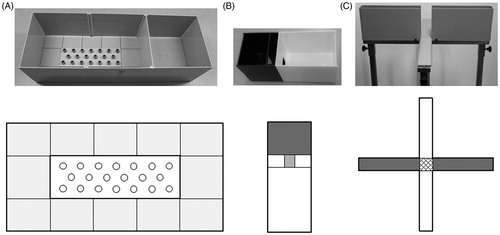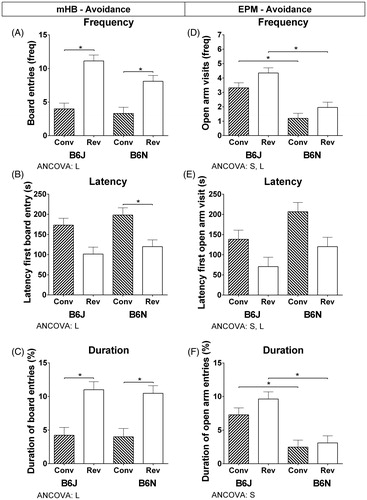Figures & data
Figure 1. Timeline of the history of the two C57BL/6 substrains used in this experiment (timeline not to scale). The C57 black subline (C57BL) was established by Clarence Little in 1921 and in 1937 the line was separated into subline 6 (and subline 10), and was maintained at the Jackson Laboratories (‘J’) resulting in the name C57BL/6J (Sacca et al., Citation2013). The C57BL/6N subline diverged in 1951 from C57BL/6J and was maintained at the NIH (‘N’). In 1974 that subline was sent to Charles River Laboratory (‘Crl’), resulting in C57BL/6NCrl (Charles River, Citation2011; Sacca et al., Citation2013). In 1974, a subline of C57BL/6J was sent to the Laboratory Animal Centre in the UK and subsequently moved to OLAC (‘Ola’) in 1983 and was finally taken over by Harlan Sprague Dawley (‘Hsd’, now Harlan Laboratories) resulting in the substrain C57BL/6JOlaHsd (Harlan Laboratories, Citation2013). See Zurita et al. (Citation2011) for a more extensive overview of the lineage of C57BL/6 substrains.

Figure 2. Pictures and schematic overviews of the behavioral set-ups used in this experiment. A: the modified Hole Board (mHB), B: the light-dark box (LD) and C: the elevated plus maze (EPM). The (light) grey areas represent the dark/’protected’ area and the white areas represent the light compartment/sections in the behavioral test set-ups. The grid lines represent the center of the EPM.

Figure 3. Selection of behavioral variables for each behavioral dimension measured in the mHB, LD and EPM. The remaining outcomes are presented in Supplementary Table S2. The frequencies of the variables are presented as medians with their IQR and the continuous data as means and SEM. Significant between-subject factors substrain (S) and light regime (L) and their interaction (S × L) resulting from the two-way ANOVA are presented below each graph and significant post hoc effects are indicated by *. Significance thresholds from the statistical analyses are presented in Supplementary Tables S2 and S3. The values are based on B6J conventional n = 23, B6J reversed n = 23, B6N conventional n = 23, B6N reversed n = 24.

Figure 4. ANCOVA results for avoidance variables in the mHB and EPM. Adjusted means and SEMs resulting from the ANCOVA with ‘Latency until first-line crossing’ as covariate for the mHB avoidance variables (A–C) and ‘Total number of closed-arm entries’ as a covariate for the EPM avoidance variables (D–F). Significant (p < .016952) between-subject factors substrain (S) and light regime (L) and their interaction (S × L) are presented below each graph and significant post hoc effects (p < .008512) are indicated by *. The values are based on B6J conventional n = 23, B6J reversed n = 23, B6N conventional n = 23, B6N reversed n = 24.

Table 1. Overview substrain differences other studies.
